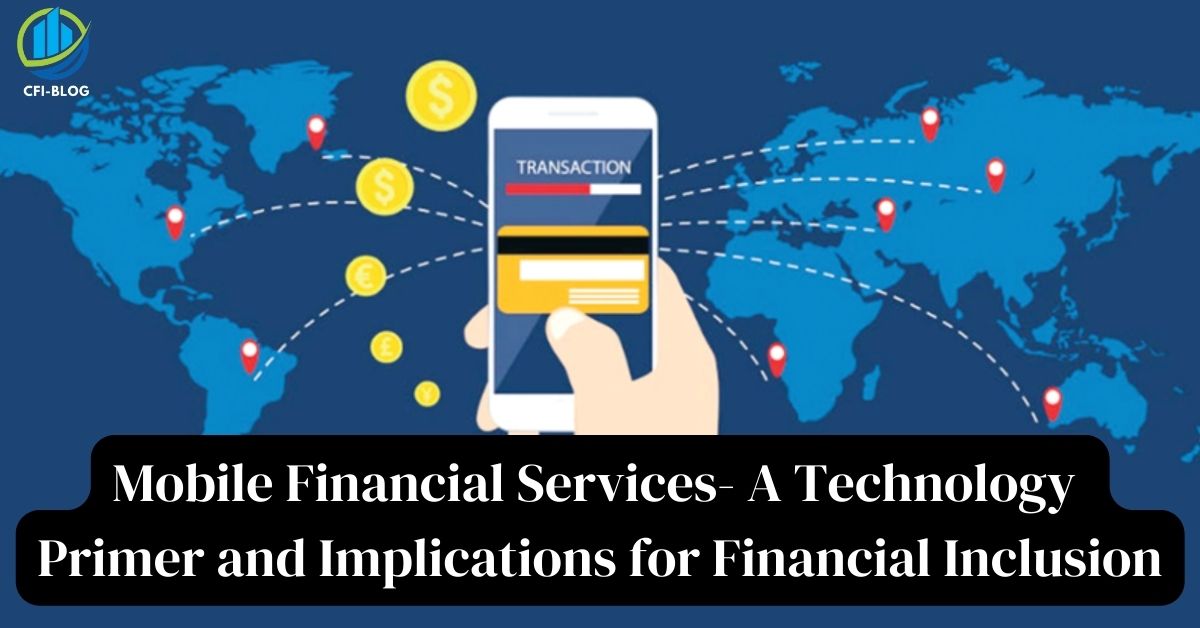We cannot deny the fact that mobiles have completely taken over. Now you can do everything through your phone, starting from watching movies, listening to music, and keeping a track of things to buying things, making payments, sending money, etc. We wake up from our phone’s alarm and sleep at night after scrolling through all the apps on our phones.
While the phone has its own pros and cons, mobile financial services have really made lives easy. If your family or friend is in urgent need of money, now you can send them money with just a few clicks on your phone and vice versa.
They not only allow you to send or receive money, but you can also store money in the online wallets offered by mobile financial services. In this article, we are going to discuss Mobile financial services- A technology primer and implications for financial inclusion. So are you ready? Let’s dive into it.
What are Mobile Financial Services?

Mobile financial services (MFS) refer to a range of financial services that can be accessed through mobile devices, such as smartphones or feature phones. These services include a wide range of financial transactions such as mobile banking, mobile payments, mobile money transfers, mobile micro-insurance, and mobile micro-lending.
They have become increasingly popular in recent years, especially in regions where traditional banking services are limited. The main reason for their popularity is, they allow customers to access financial services conveniently and efficiently, regardless of their location or time of day. They have also proven to be an effective way to promote financial inclusion by providing access to banking services to those who are unbanked or underbanked.
Some examples of MFS include mobile wallets, which allow users to store and access funds using their mobile devices, and mobile banking, which enables customers to access their bank accounts, check their balances, and transfer funds between accounts using their mobile devices. Mobile payments are also a popular MFS, allowing customers to pay for goods and services using their mobile devices rather than cash or traditional payment methods.
How Mobile Financial Services are Helping in Financial Inclusion?

Financial inclusion means a system where the financial needs of everyone are being fulfilled, be that rich or poor, urban or rural people. Some examples of financial inclusion are asset-based financing and flexible repayment schedule to better serve Africa’s smallholder farmers, and foster responsible finance in Myanmar’s infant industry.
In recent times, mobile financial services (MFS) are playing a critical role in expanding financial inclusion and promoting financial empowerment in many parts of the world, especially in developing countries where traditional banking services are not accessible or affordable for large segments of the population.
Here are some ways in which Mobile financial services- A technology primer and implications for financial inclusion are working:
1. Increased Access
MFS has made it possible for people to access financial services through their mobile phones, even in remote areas where traditional banking services are unavailable. This has helped to reach the population that does not have access to banks, allowing them to open a bank account, deposit and withdraw money, and even access credit just with a few clicks on their phone.
2. Low Transaction Costs
Mobile banking services have significantly reduced the transaction costs associated with financial services. Mobile payments and transfers are often cheaper than traditional banking services, making them more affordable and accessible to low-income individuals.
3. Ease of Use
It is simple and easy to use, even for people with limited literacy skills. Transactions can be done through basic mobile phones and without the need for an internet connection. This has made financial services more accessible to those who previously may have been excluded from the formal financial system. Now, you can even have access to microfinance with your phone. Moreover, governments are also using microfinance as a tool to fight corruption.
4. Financial Literacy
Mobile finance services often offer financial literacy programs and resources to help users better understand financial management and make the right decisions about their money. This also informs you about what impact investors learn from microfinance.
5. Small Business Empowerment
These services have enabled small businesses and entrepreneurs to access financial services, such as loans, that were previously inaccessible. This has helped to stimulate economic growth and create new job opportunities. China’s microfinance landscape nonprofits microcredit companies and Aliabara is a good examples of financial inclusion.
Frequently Asked Questions (FAQs)
Q1. How mobile money agents can expand financial inclusion?
Here are some ways how mobile money agents can expand financial inclusion:
- Make loan policies that are more inclusive and serve not only high-income and urban people but also low-income people and people living in semi-urban and rural areas.
- By offering accessible and affordable financial services to people who do not have access to banks.
- They should offer multiple types of loans like personal loans, secured loans, unsecured loans, microloans, payday loans, business loans, etc so that the needs of everyone can be fulfilled.
- The loan terms and especially the loan repayment schedule should be flexible.
- By educating people about finances and offering services like loan management.
Q2. What is financial inclusion through digital financial services?
In general, people living in urban areas have easy access to banking services, loans, etc. But when it comes to people living in rural areas, they neither have enough financial literacy, nor access to banking services. But now with the help of digital financial services, even people in rural areas have access to banking services like sending and receiving money, getting loans at affordable rates, online wallets, etc. Digital financial services have reached people where traditional banks could never go.
Q3. Is mobile money promoting financial inclusion?
Yes. Mobile money services are definitely promoting financial inclusion. Now someone who lives in a village can send and receive money without traveling to the bank which is miles away. They can also get loans, financial education, etc through their mobile phones.
Conclusion
Lastly, mobile financial services are transforming the way people access financial services and promoting financial inclusion, especially for low-income individuals and those living in remote areas. All in all, these services have revolutionized the financial services for people living in urban areas.
Author Profile

- Jonas Taylor is a financial expert and experienced writer with a focus on finance news, accounting software, and related topics. He has a talent for explaining complex financial concepts in an accessible way and has published high-quality content in various publications. He is dedicated to delivering valuable information to readers, staying up-to-date with financial news and trends, and sharing his expertise with others.
Latest entries
 BlogOctober 30, 2023Exposing the Money Myth: Financing Real Estate Deals
BlogOctober 30, 2023Exposing the Money Myth: Financing Real Estate Deals BlogOctober 30, 2023Real Estate Success: Motivation
BlogOctober 30, 2023Real Estate Success: Motivation BlogOctober 28, 2023The Santa Claus Rally
BlogOctober 28, 2023The Santa Claus Rally BlogOctober 28, 2023Build Your Team – the Importance of Networking for Traders
BlogOctober 28, 2023Build Your Team – the Importance of Networking for Traders

